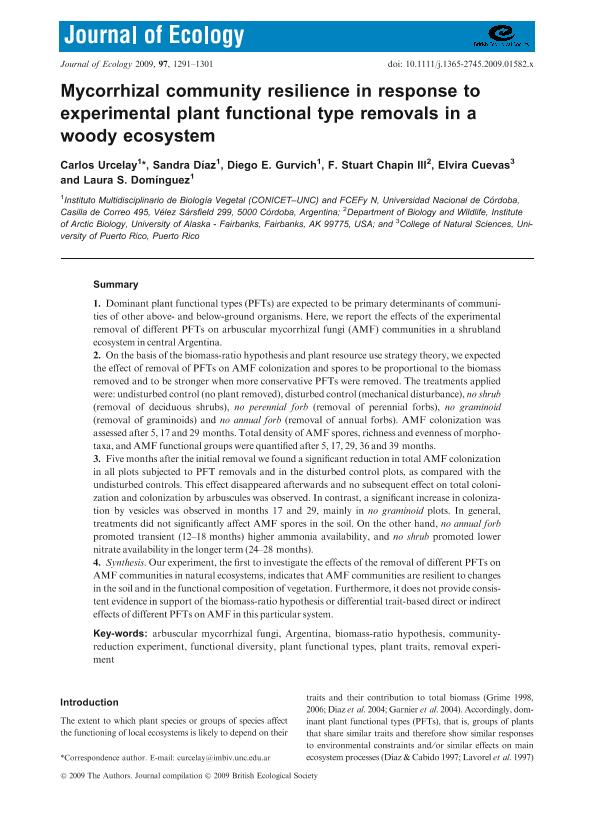Mostrar el registro sencillo del ítem
dc.contributor.author
Urcelay, Roberto Carlos

dc.contributor.author
Díaz, Sandra Myrna

dc.contributor.author
Gurvich, Diego Ezequiel

dc.contributor.author
Chapin, F. Stuart
dc.contributor.author
Cuevas, Elvira
dc.contributor.author
Dominguez, Laura Susana

dc.date.available
2017-09-20T16:58:28Z
dc.date.issued
2009-09
dc.identifier.citation
Urcelay, Roberto Carlos; Díaz, Sandra Myrna; Gurvich, Diego Ezequiel; Chapin, F. Stuart; Cuevas, Elvira; et al.; Mycorrhizal community resilience in response to experimental plant functional type removals in a woody ecosystem; Wiley; Journal of Ecology; 97; 6; 9-2009; 1291-1301
dc.identifier.issn
0022-0477
dc.identifier.uri
http://hdl.handle.net/11336/24682
dc.description.abstract
1. Dominant plant functional types (PFTs) are expected to be primary determinants of communities of other above- and below-ground organisms. Here, we report the effects of the experimental removal of different PFTs on arbuscular mycorrhizal fungi (AMF) communities in a shrubland ecosystem in central Argentina. 2. On the basis of the biomass-ratio hypothesis and plant resource use strategy theory, we expected the effect of removal of PFTs on AMF colonization and spores to be proportional to the biomass removed and to be stronger when more conservative PFTs were removed. The treatments applied were: undisturbed control (no plant removed), disturbed control (mechanical disturbance), no shrub (removal of deciduous shrubs), no perennial forb (removal of perennial forbs), no graminoid (removal of graminoids) and no annual forb (removal of annual forbs). AMF colonization was assessed after 5, 17 and 29 months. Total density of AMF spores, richness and evenness of morphotaxa, and AMF functional groups were quantified after 5, 17, 29, 36 and 39 months. 3. Five months after the initial removal we found a significant reduction in total AMF colonization in all plots subjected to PFT removals and in the disturbed control plots, as compared with the undisturbed controls. This effect disappeared afterwards and no subsequent effect on total colonization and colonization by arbuscules was observed. In contrast, a significant increase in colonization by vesicles was observed in months 17 and 29, mainly in no graminoid plots. In general, treatments did not significantly affect AMF spores in the soil. On the other hand, no annual forb promoted transient (12–18 months) higher ammonia availability, and no shrub promoted lower nitrate availability in the longer term (24–28 months). 4. Synthesis. Our experiment, the first to investigate the effects of the removal of different PFTs on AMF communities in natural ecosystems, indicates that AMF communities are resilient to changes in the soil and in the functional composition of vegetation. Furthermore, it does not provide consistent evidence in support of the biomass-ratio hypothesis or differential trait-based direct or indirect effects of different PFTs on AMF in this particular system.
dc.format
application/pdf
dc.language.iso
eng
dc.publisher
Wiley

dc.rights
info:eu-repo/semantics/openAccess
dc.rights.uri
https://creativecommons.org/licenses/by-nc-sa/2.5/ar/
dc.subject
Mycorrhizae
dc.subject
Removal Experiments
dc.subject
Plant Functional Traits
dc.subject
Biodiversity
dc.subject
Argentina
dc.subject.classification
Bioquímica y Biología Molecular

dc.subject.classification
Ciencias Biológicas

dc.subject.classification
CIENCIAS NATURALES Y EXACTAS

dc.title
Mycorrhizal community resilience in response to experimental plant functional type removals in a woody ecosystem
dc.type
info:eu-repo/semantics/article
dc.type
info:ar-repo/semantics/artículo
dc.type
info:eu-repo/semantics/publishedVersion
dc.date.updated
2017-09-15T20:07:49Z
dc.identifier.eissn
1365-2745
dc.journal.volume
97
dc.journal.number
6
dc.journal.pagination
1291-1301
dc.journal.pais
Estados Unidos

dc.journal.ciudad
Hoboken
dc.description.fil
Fil: Urcelay, Roberto Carlos. Consejo Nacional de Investigaciones Científicas y Técnicas. Centro Científico Tecnológico Conicet - Córdoba. Instituto Multidisciplinario de Biología Vegetal. Universidad Nacional de Córdoba. Facultad de Ciencias Exactas Físicas y Naturales. Instituto Multidisciplinario de Biología Vegetal; Argentina
dc.description.fil
Fil: Díaz, Sandra Myrna. Consejo Nacional de Investigaciones Científicas y Técnicas. Centro Científico Tecnológico Conicet - Córdoba. Instituto Multidisciplinario de Biología Vegetal. Universidad Nacional de Córdoba. Facultad de Ciencias Exactas Físicas y Naturales. Instituto Multidisciplinario de Biología Vegetal; Argentina
dc.description.fil
Fil: Gurvich, Diego Ezequiel. Consejo Nacional de Investigaciones Científicas y Técnicas. Centro Científico Tecnológico Conicet - Córdoba. Instituto Multidisciplinario de Biología Vegetal. Universidad Nacional de Córdoba. Facultad de Ciencias Exactas Físicas y Naturales. Instituto Multidisciplinario de Biología Vegetal; Argentina
dc.description.fil
Fil: Chapin, F. Stuart. University Of Alaska; Estados Unidos
dc.description.fil
Fil: Cuevas, Elvira. Universidad de Puerto Rico; Puerto Rico
dc.description.fil
Fil: Dominguez, Laura Susana. Consejo Nacional de Investigaciones Científicas y Técnicas. Centro Científico Tecnológico Conicet - Córdoba. Instituto Multidisciplinario de Biología Vegetal. Universidad Nacional de Córdoba. Facultad de Ciencias Exactas Físicas y Naturales. Instituto Multidisciplinario de Biología Vegetal; Argentina
dc.journal.title
Journal of Ecology

dc.relation.alternativeid
info:eu-repo/semantics/altIdentifier/url/http://onlinelibrary.wiley.com/doi/10.1111/j.1365-2745.2009.01582.x
dc.relation.alternativeid
info:eu-repo/semantics/altIdentifier/doi/http://dx.doi.org/10.1111/j.1365-2745.2009.01582.x
Archivos asociados
